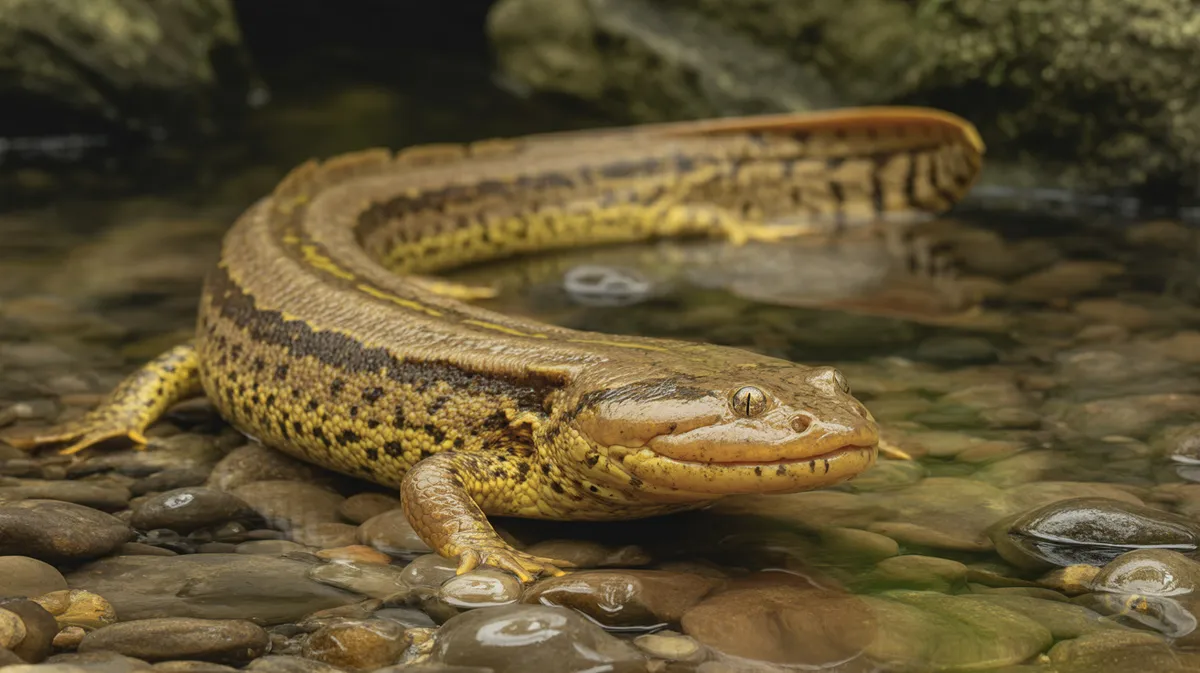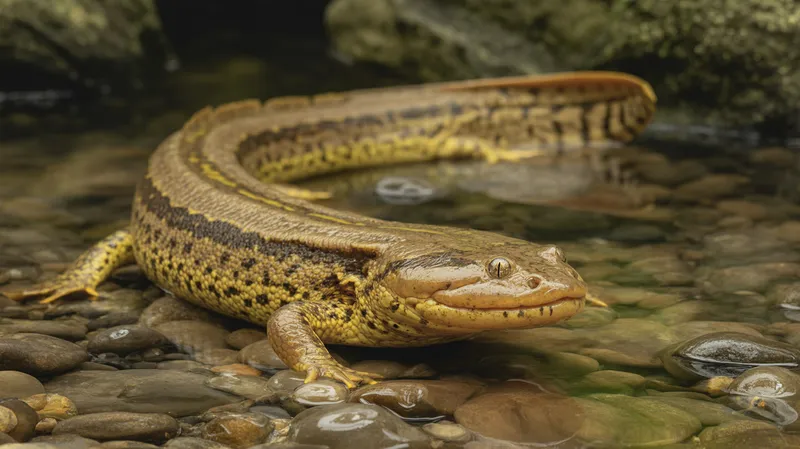
Eastern Hellbender
Cryptobranchus alleganiensis alleganiensis

Meet the Eastern Hellbender
The Eastern Hellbender is the largest aquatic salamander in North America, reaching lengths up to 29 inches. This secretive amphibian inhabits clean, fast-flowing streams and rivers, where it hides under large, flat rocks. Its slimy, flattened body and loose, frilled skin help with cutaneous respiration, as it absorbs oxygen directly through its skin. Hellbenders are highly sensitive to water pollution and habitat disturbance, making them important indicators of freshwater ecosystem health.
Classification
Amphibian
Habitat
Fast-flowing, rocky streams and rivers
Diet
Carnivore
Lifespan
25-30 years
Conservation
Near Threatened
Weight
1.5–5.5 lbs (0.7–2.5 kg)
📖Fascinating Facts
Aquatic Lifestyle
Eastern Hellbenders spend their entire lives in water and are rarely, if ever, found on land.
Skin Breathers
They rely on their loose, frilly skin folds to absorb oxygen directly from the water, making clean rivers essential for their survival.
Parental Protection
Males guard the nest and fan eggs with their tails to provide oxygen, protecting them from predators and silt.
📋Detailed Description
The Eastern Hellbender (Cryptobranchus alleganiensis alleganiensis) is a fully aquatic salamander and the largest amphibian in North America, with adults typically measuring 29–74 cm (11–29 in) in length and weighing up to 2.5 kg (5.5 lbs). Its dorsoventrally flattened body and broad, paddle-like tail are specialized for life in fast-flowing streams. The skin is loose and heavily folded along the flanks, increasing surface area for cutaneous respiration, which is vital as the species lacks gills in adulthood and has small, functionally limited lungs. Coloration ranges from mottled brown to olive, often with darker spots, providing camouflage among submerged rocks. The head is broad and flat, with small, lidless eyes adapted for low-light underwater environments. Limbs are short but robust, with well-developed digits for anchoring under rocks. Hellbenders are primarily nocturnal, emerging from daytime refuges beneath large stones to hunt at night. They are solitary and highly territorial, with individuals defending shelter sites from conspecifics. Their secretive nature and reliance on pristine, oxygen-rich water make them sensitive indicators of stream health.
💡 Did you know?
Despite their intimidating appearance and name, hellbenders are completely harmless to humans and play a crucial role in maintaining healthy stream ecosystems.
🔬Research & Sources
Wikipedia Summary
The hellbender, also known as the hellbender salamander, is a species of aquatic giant salamander endemic to the eastern and central United States. It is the largest salamander in North America. A member of the family Cryptobranchidae, the hellbender is the only extant member of the genus Cryptobranchus. Other closely related salamanders in the same family are in the genus Andrias, which contains the Japanese and Chinese giant salamanders. The hellbender is much larger than any other salamander in its geographic range, and employs an unusual adaption for respiration through cutaneous gas exchange via capillaries found in its lateral skin folds. It fills a particular niche—both as a predator and prey—in its ecosystem, which either it or its ancestors have occupied for around 65 million years. The species is listed as Vulnerable on the IUCN Red List of Threatened Species due to the impacts of disease and widespread habitat loss and degradation throughout much of its range.
Last Modified: 5/25/2025
🎭Behavior & Social Structure
Eastern Hellbenders are predominantly nocturnal, spending daylight hours concealed beneath large, flat rocks or submerged logs. They exhibit strong site fidelity, often occupying the same shelter for extended periods. Hellbenders are ambush predators, feeding mainly on crayfish, but also consuming small fish, aquatic insects, worms, and occasionally amphibians. They use a rapid sideways snap of the jaws to capture prey, relying on tactile and chemical cues rather than vision. Social interactions are limited outside of the breeding season, with individuals displaying aggressive behaviors such as biting and posturing to defend territories. Hellbenders are generally sedentary, with home ranges rarely exceeding a few hundred meters of stream length. During periods of high water flow or disturbance, they may temporarily relocate but typically return to established shelters.
👶Reproduction & Life Cycle
Breeding occurs annually in late summer to early autumn (typically August–September), triggered by declining water temperatures. Males establish and defend nesting sites beneath large rocks or within crevices, excavating shallow depressions in the substrate. Females are attracted to these nests, where they deposit between 150 and 500 eggs in a single clutch. Males fertilize the eggs externally and remain to guard the nest for up to 2–3 months, fanning the eggs with their tails to ensure adequate oxygenation and protect them from predators and siltation. This form of paternal care is unusual among salamanders. Embryonic development lasts 45–75 days, depending on water temperature. Upon hatching, larvae are 25–30 mm (1–1.2 in) long, possess external gills, and remain in the nest for several days before dispersing. Sexual maturity is reached at 5–8 years, and individuals can live over 25 years in the wild.
🛡️Adaptations & Survival
The Eastern Hellbender exhibits several unique adaptations for its aquatic lifestyle. Its lateral skin folds dramatically increase surface area for cutaneous gas exchange, compensating for the limited function of its small lungs. The flattened body and broad tail enhance stability and propulsion in swift currents, while strong, webbed limbs aid in digging and anchoring under rocks. Reduced vision is offset by a highly developed lateral line system and chemoreceptive abilities, allowing detection of prey and conspecifics in turbid water. The skin secretes a thick, mucous coating that reduces friction, deters some predators, and may have antimicrobial properties. Behavioral adaptations include nocturnality to avoid diurnal predators and minimize competition, and strong territoriality to secure optimal shelter sites.
🎨Cultural Significance
The hellbender has a colorful presence in local folklore and regional culture, often referred to by nicknames such as 'snot otter,' 'devil dog,' or 'Allegheny alligator.' Its unusual appearance and secretive habits have inspired myths and superstitions, sometimes being regarded as a bad omen or a creature to be feared. In recent years, the hellbender has become a symbol of clean water advocacy and conservation in the eastern United States, serving as the official state amphibian of Pennsylvania. Educational campaigns and citizen science initiatives have increased public awareness and appreciation for this unique species.
🔬Recent Research & Discoveries
Recent research has focused on the impacts of environmental stressors on hellbender health, including studies on the effects of water quality, disease prevalence, and genetic diversity across fragmented populations. Advances in environmental DNA (eDNA) techniques have improved detection and monitoring of hellbender populations, aiding conservation efforts. Ongoing studies are investigating the efficacy of head-starting programs, where captive-reared juveniles are released into the wild to bolster declining populations. Research into the species' microbiome and skin secretions may yield insights into disease resistance and potential biomedical applications. Long-term ecological studies continue to refine understanding of hellbender life history, habitat requirements, and responses to restoration interventions.
🎥Wildlife Videos

The Last Dragons - Preserving Appalachia's Hellbenders
An intimate glimpse at North America's Eastern Hellbender, an ancient salamander that lives as much in myth as in reality.... and ...
Freshwaters Illustrated

In search of the Eastern Hellbender Salamander
The Eastern Hellbender salamander is the largest salamander in North America! Join Travel For Wildlife as we venture into a ...
Travel For Wildlife

Hellbender in the Blue
by: Katelyn Calhoun From New York to Appalachia, the two-foot-long Eastern hellbender salamander is an indicator species of ...
Indiana Humanities

Resident Animals: Eastern Hellbender
Did you know? Eastern Hellbenders are Ohio's largest amphibian and America's largest salamander!
Lake Erie Nature & Science Center

What's a Hellbender?
Kat Diersen, our Southeast Program Representative, explains what an eastern hellbender is and why they're so cool! Video ...
Defenders of Wildlife

Returning Hellbender Salamanders to the Wild | Secrets of the Zoo
About National Geographic Wild: National Geographic Wild is a place for all things animals and for animal-lovers alike. Take a ...
Nat Geo Animals
🌍Habitat Information
The Eastern Hellbender typically inhabits Fast-flowing, rocky streams and rivers environments. Eastern Hellbenders have adapted to their environments with specialized features and behaviors.
Primary Habitat:
Fast-flowing, rocky streams and rivers
More detailed habitat information will be available soon.
🛡️Conservation Status
The Eastern Hellbender is currently classified as Near Threatened. Conservation efforts are crucial for preserving this species for future generations.
Common Threats:
- 🏠Habitat loss and fragmentation
- 🌡️Climate change impacts
- 🎯Hunting and poaching
- 🏭Human-wildlife conflict
⚠️Threats & Conservation Challenges
Eastern Hellbender populations are declining throughout their range due to multiple anthropogenic threats. Habitat degradation from sedimentation, dam construction, and channelization reduces the availability of clean, rocky substrates essential for nesting and shelter. Agricultural runoff, mining, and urbanization contribute to water pollution, which impairs respiration and increases susceptibility to disease. Emerging infectious diseases, notably chytridiomycosis (caused by Batrachochytrium dendrobatidis) and ranavirus, pose significant risks. Collection for the pet trade and use as fishing bait has historically impacted some populations. Climate change may further threaten the species by altering stream flow regimes and water temperatures. The IUCN currently lists the Eastern Hellbender as Vulnerable, with some local populations considered Endangered or extirpated. Conservation efforts focus on habitat restoration, captive breeding, head-starting programs, and public education.
🔬Scientific Classification
Scientific Name
Cryptobranchus alleganiensis alleganiensis
Classification Hierarchy
🔍 About Taxonomic Classification
Taxonomic classification is a hierarchical system used by scientists to classify and organize living organisms based on shared characteristics and evolutionary relationships.
The system moves from broad categories (Kingdom) to increasingly specific ones, with each animal's scientific name typically consisting of its Genus and species.
📝Community Notes
Share your observations and insights about the Eastern Hellbender with our community of wildlife enthusiasts.
Join Our Community
Sign in to share your observations and connect with fellow wildlife enthusiasts.
Sign In to ContributeNo community notes yet
Be the first to share your observations about the Eastern Hellbender!
Explore Eastern Hellbender
Select a tab above to learn more about this amazing animal.
📸Photo Gallery
No photos available for this animal yet.
🌟Discover More Wildlife
Continue your journey of discovery with more fascinating animals from our database
